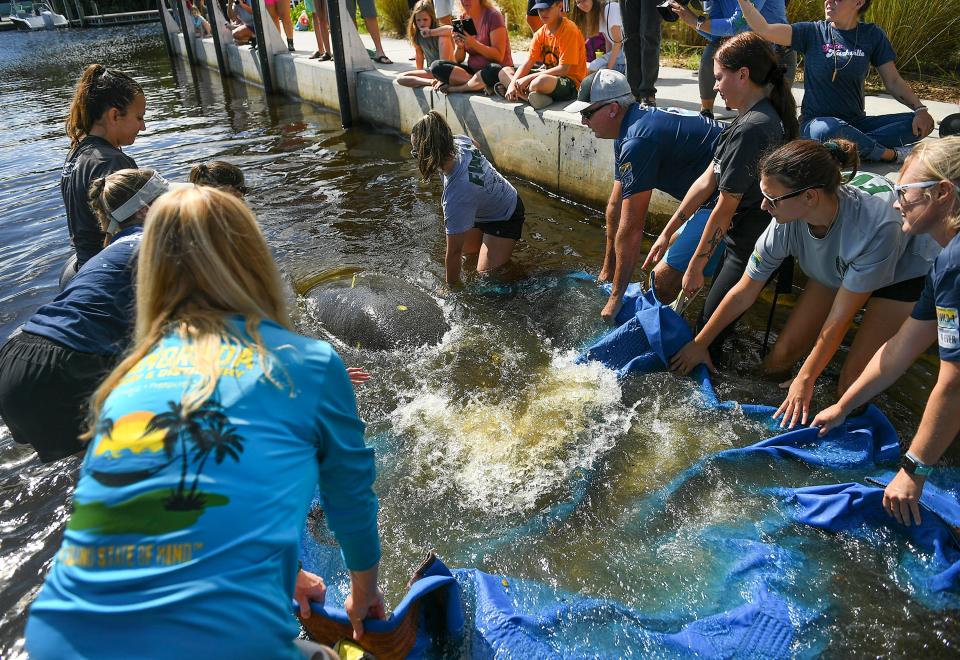Manatee released into Martin County waters brings hope during a tough year for Florida icon
STUART — Hope comes in many forms. On Wednesday, hope was a rotund 735-pound manatee, swimming her way home after more than five months of recovery.
"Sheep," an 8-foot-long young adult female manatee, was released into Frazier Creek, a tributary of the St. Lucie River in Stuart. She was rescued in May after a boat collision in Martin County left her weak and floating on her side.
After being reported May 12 to the Florida Fish and Wildlife Conservation Commission, the manatee was relocated 110 miles south to Miami Seaquarium, where she's spent the last half-year growing strength, adding fat to her frame and regaining her energy.
Can we feed them?: Manatees are starving to death in Florida. Experts weigh pros, cons of feeding them
$7M worth of lettuce: Starving manatees: Will Florida spend $7 million more to help save them?
Can Congress help manatees?: Manatee Protection Act would reclassify manatees as endangered. Now what happens?

Don't call it a come back
Florida wildlife officials released the gentle marine mammal from the boat ramp at Shepard Park in Stuart with the help of Florida Atlantic University's Harbor Branch Oceanographic Institute and the Miami aquarium. She was cheered on by more than 40 enthusiastic bystanders.
"Seeing her come back and being released back into the wild is a great accomplishment for everyone involved," said Steve Burton, director of stranding and population assessment at the Fort Pierce-based Harbor Branch. "It's a great thing to watch."
It's been an especially tough year for Florida's beloved sea cows: A record 988 manatees have died through Oct. 29, according to state data updated Wednesday. Biologists point to seagrass loss in the Indian River Lagoon as a catalyst for starvation and malnutrition.
As cooler temperatures arrive to the Sunshine State, wildlife officials fear another rough winter for manatees could be in store as they begin to gather in warm-water areas with little food to go around.
It’s been a tough year for Florida’s manatees, but today there’s good news.
A 735-lb female was just released by @MyFWC in Stuart, FL after a May boat strike here. She was rehabbed at @MiamiSeaquarium pic.twitter.com/SU78Ly1lZ6— Max Chesnes (@MaxChesnes) November 3, 2021
But Sheep — whose nickname is a play on "Shepard Park" — still has some time to travel and forage before water temperatures start to drop, according to Julie Heyde, an animal care supervisor at Miami Seaquarium.
While some manatees rescued during this year's die-off were equipped with tracking belts before released, Sheep was given microchips (similar to those found in pet dogs or cats) in case she's rescued again in the future, Heyde said.
"She was always very active in the pool," Heyde said of Sheep's time in recovery. "She definitely has a sassy personality."
Roughly 75% of the manatees at Miami Seaquarium are rehabilitated for boat strikes, Heyde said. At least 89 were killed this year from watercraft, compared to 91 in all of 2020, state data show.
November is also "Manatee Awareness Month," and as the animals begin to relocate to warmer waters, boaters should begin to take extra caution, said FWC regional director Tom Reinert. He added boaters should wear polarized glasses to help see clearer into the water.
"Manatees are on the move," Reinert said. "Keep an eye out."
Report sick, injured, dead manatees
Contact FWC's Wildlife Alert Hotline by calling toll-free at 888-404-3922 (FWCC), emailing Tip@MyFWC.com or using VHF Channel 16 on your boat.
Manatee protection: How boaters can help
Consult a boater’s guide for each county you visit to learn the manatee speed zones.
Obey posted speed zone signs and keep away from posted manatee sanctuaries.
Avoid seagrass beds and shallow areas where manatees might be feeding.
Stay in deep-water channels, but beware manatees travel in them too.
Don't jet ski, water ski or do other high-speed watersports where manatees frequent. Stick to land-locked lakes or waters well offshore.
Wear polarized glasses to eliminate the sun's glare and see below the water surface.
Look for a snout, back, tail, flipper as well as a flat spot or swirl of water, which manatees create when they flap their tail to dive or swim.
Remain at least 50 feet away from a manatee and cut your motor to sit and observe it. Remember, it is illegal to feed and give water to manatees.
For more news, follow Max Chesnes on Twitter.
Max Chesnes is a TCPalm environment reporter focusing on issues facing the Indian River Lagoon, St. Lucie River and Lake Okeechobee. You can keep up with Max on Twitter @MaxChesnes, email him at max.chesnes@tcpalm.com and give him a call at 772-978-2224.
This article originally appeared on Treasure Coast Newspapers: Manatee, rehabbed after vessel strike, released into St. Lucie River

